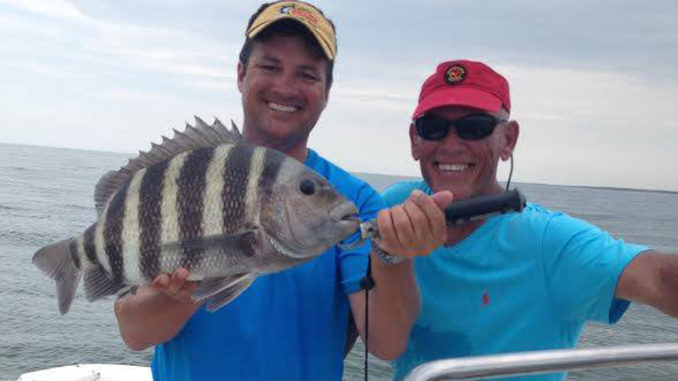
April is great for nearshore sheepshead
Every winter, when the water cools, it shakes things up for fishermen along the eastern seaboard, especially around Murrells Inlet, when the inshore waters turn into ghost towns and many fish, including the snaggle-toothed sheepshead, head to the ocean to make a living.
Sheepshead take the opportunity to congregate around nearshore rocks and reefs, spawning through the cold months and feeding like there’s no tomorrow. By the end of April, the mating game ends, and fish head back toward the beach, but the last couple of weeks before the move, the bite can be incredible.
Sheepshead are brutes, known for their commanding strength but ultra-delicate strikes. Guide Ned Campbell, who owns Murrell’s Inlet Outpost knows how to find and tame these striped bandits as the calendar changes over to spring.
“Sheepshead bite from February through April in the ocean,” said Campbell (843-460-0186). “They leave the ocean and come back into the inlet when the ocean water temperature climbs into the upper 50s.”
When they’re hanging around rocks and reefs, big schools of sheepshead gnaw away at every barnacle and any other living creature adhered to the structure. As winter wanes, less food is available, and the energy exerted from spawning increases their hunger pangs immensely. Anything resembling something tasty may get a touch from a sheepshead this time of year. It is the perfect storm for anglers equipped with the sheepshead’s favorite grub.
“They should be real hungry. They will tear up live fiddlers,” said Campbell.
Fresh fiddler crabs are his top choice for bait, but Campbell will use frozen fiddlers, clams and cut shrimp when live fiddlers are scarce. He prefers to hook the fiddlers on ½- to 1-ounce jigheads because of the subtle bite, but a typical Carolina rig with an egg sinker and short leader will work.
“The jighead eliminates slack line and helps you feel the bite. It is an acquired feel,” Campbell said.
While all of nearshore reefs out of Murrells Inlet will hold fish, they won’t always be on every reef. Anglers will have to search to find which reef is holding the most fish.
“We fish inside an 11-mile umbrella from Murrells Inlet, including the 10-mile, 11-mile, Pawleys and North Inlet reefs,” he said..
Campbell visits the reefs and fishes around until he finds a decent-sized school, but they are not always in the same spot on each reef. He starts on one side and work his way to the other until he finds a group of fish.
“If they are there, they will eat pretty quick,” he said.
Sometimes Campbell will use chum to help get them corralled in one spot too. Crushed up barnacles, clams, and oysters will quickly do the trick.





Be the first to comment